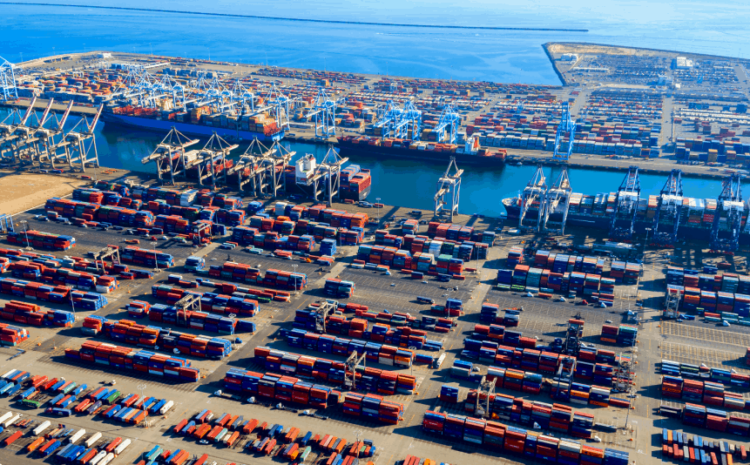Raw materials stuck in transit costing economy billions
By Terry Troy
While we all heard about the ship stuck in the Suez Canal causing a supply chain backup, the problem still is more widespread and dire across many of our nation’s major ports. According to the National Association of Manufacturers (NAM) the massive traffic jam at our national ports, like those of Los Angeles and Long Beach, is costing our economy and manufacturers in particular, many billions of dollars.
However, the situation appears to be easing. The Wall Street Journal reported in April that there were 23 ships waiting to dock at those two ports, down from about 40 back in February. The normal number of ships waiting in the harbor is usually somewhere between zero and 1, according to Ben Siegrist, the NAM’s director of infrastructure, innovation and human resources policy.
According to the NAM, much of the congestion is a result of the pandemic. While there has been an uptick in e-commerce during the pandemic, the economic stimulus boosted consumption. And the typical increase in shipments during the holiday season just made things worse.
Other contributing factors include a shortage of shipping containers, with some shippers finding it less expensive to ship the containers back to Asia, much to the chagrin of U.S. manufacturers who want to load the containers with exports.
The trucks that transport containers to warehouses require a special chassis to move the containers, but major ports also don’t have enough of these. And there is a labor shortage, as many port workers had to deal with the pandemic, or cope with family responsibilities caused by COVID.
Meanwhile, the logistics of international shipping are incredibly complicated, Siegrist explained. There are fewer ocean carriers today—only nine, down from more than 20 a few decades ago—which means manufacturers have fewer competitive shipping options. And the complex relationships between the multiple carriers, port operators and equipment owners are not easy to disentangle or control.
Thanks in large part to the complexity of international shipping, there’s no easy answer, said Siegrist. Right now, the NAM is in discussions with the many federal agencies involved in international commerce, including the Department of Transportation, the Department of Commerce, the Office of the U.S. Trade Representative and a lesser known but vital agency called the Federal Maritime Commission.
“We’re trying to create opportunities for our members to have a dialogue with policymakers,” said Siegrist.
The eventual policy options might range from fines or fees for international carriers to legislative updates to the 1984 Shipping Act. It will also be important to strengthen the domestic supply chain for equipment like containers—almost none of which are now
made in the U.S. The NAM is “talking more holistically about supply chains with the Biden administration,” noted Siegrist.
In related news, NAM President and CEO, Jay Timmons applauded Senate Republicans following the unveiling of an infrastructure framework.
“Manufacturers applaud Senate Republicans’ proposal for infrastructure investment, just as we welcomed the release of President Biden’s bold infrastructure plan,” said Timmons. “This type of give-and-take is how we reach bipartisan consensus, and this is a chance to continue the conversation and restore trust between the parties after months of partisanship.

“Manufacturers’ future depends on historic investment that will empower America to lead the world in modern infrastructure. Building the next, post-pandemic world requires investing in roads, bridges, pipes, waterways, 5G, the electric grid and so much more. As manufacturers have laid out in our ‘Building to Win’ plan, we not only have a vision of where to invest but also how to pay for it without harming manufacturers’ competitiveness. So, we look forward to working with both parties to finally get this done.”
Closer to home, Ohio’s unemployment rate in March fell to 4.7% compared to 6% nationwide, while participation rate was 62.1% compared to 61.5% nationwide.
Meanwhile, Ohio’s manufacturing employment grew in March by 2,200. Year over year, Ohio manufacturing has lost 33,000 jobs, with 30,700 fewer positions in durable goods and 2,300 fewer in non-durable goods, according to the Ohio Department of Jobs and Family Services.
Individual companies in Ohio are also on the move. Superior Roll Forming, a Welser Profile Company and a leading manufacturer of custom roll formed metal products for the automotive, aerospace, construction and solar industries, moved forward with its plans to expand in Valley City in Medina County. The Ohio Tax Credit Authority last week approved the company’s expansion plans for tax credit assistance.
Superior plans to add 150 new jobs, while retaining more than 220 current positions. The company is renovating a building to house its new workforce near its current facility.
“Everyone at Superior Roll Form, a Welser Profile company, would like to thank Team NEO and JobsOhio for their support and commitment to this project,” said Bill Johnson, president and CEO, Welser, Inc. “We are very excited to continue our expansion plans in North America. We are blessed with great employees and a community that is so committed to our success. We look forward to adding more team members to the Welser Profile family in Ohio.”
Edge Plastics, a manufacturer of industrial injection molded products located in Mansfield, also plans to expand. In addition to adding 67 new hires, the company will retain 85 employees and add almost 35,000 square feet to the company’s manufacturing facility.
“Edge Plastics Inc. began manufacturing as D&M Plastics in 1975. The company was started by my parents, Marilyn and David Eckstein and I purchased the company from them in 2005,” said Shelley Fisher, president of Edge Plastics. “Our whole team is so excited to continue our growth in Mansfield and to be contributing to the economic viability of the region. It’s wonderful to see our economic partners work with companies like ours to create jobs and expand our businesses locally and throughout Ohio.”


